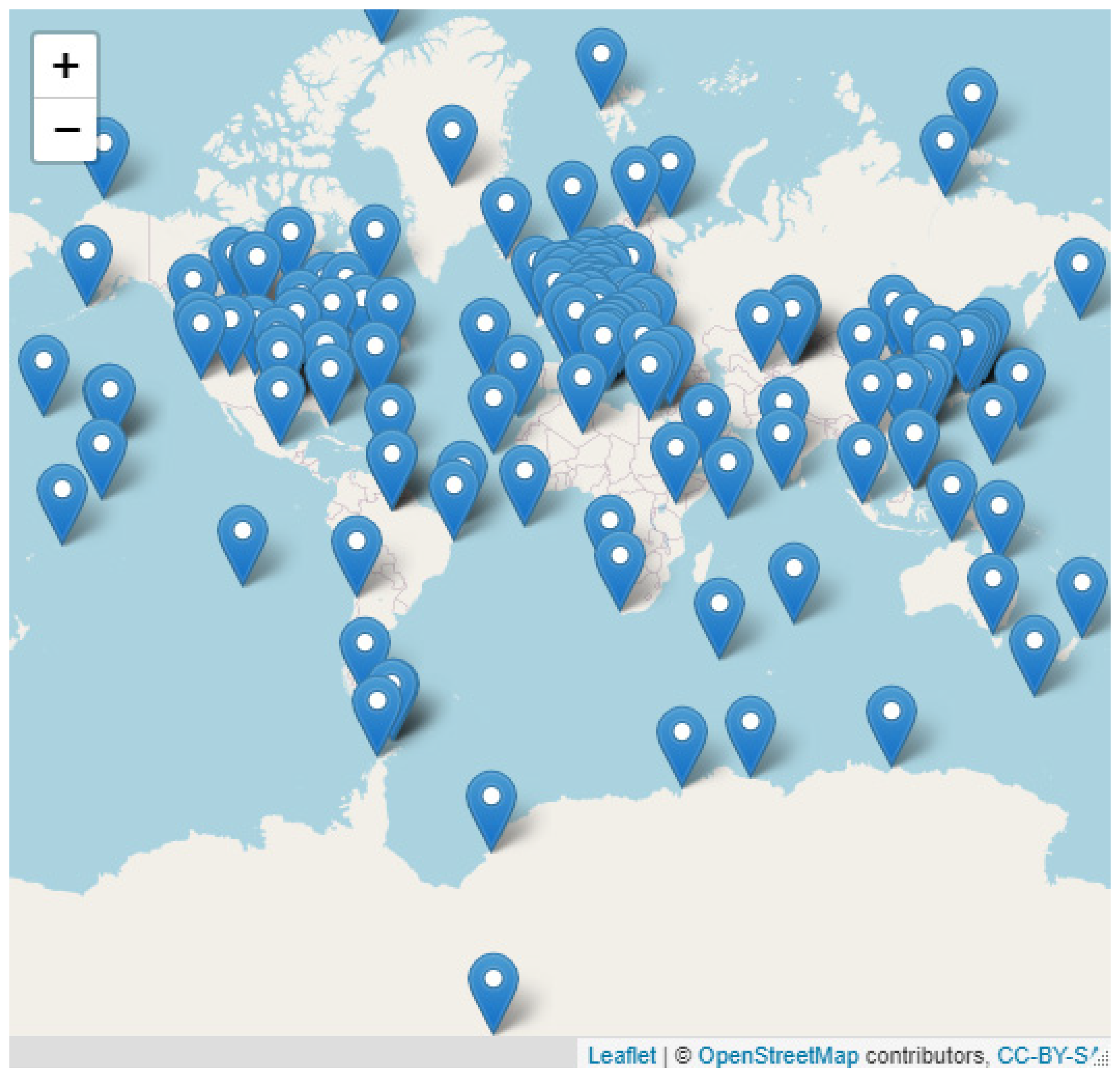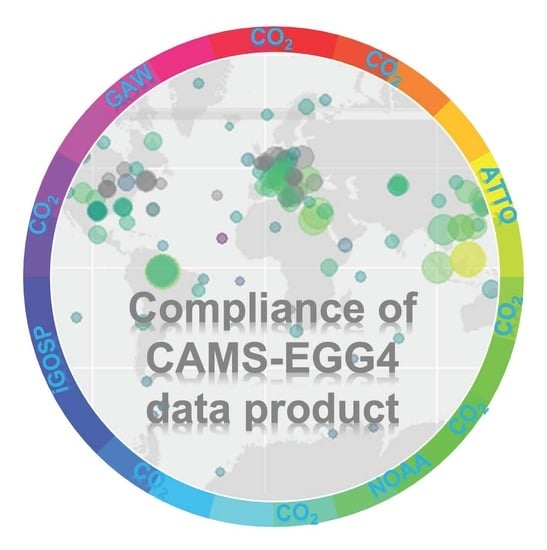Worldwide Evaluation of CAMS-EGG4 CO2 Data Re-Analysis at the Surface Level
Abstract
:1. Introduction
2. Datasets and Methods
2.1. Datasets
2.1.1. CAMS-EGG4
- Bias correction for CO2 ecosystem fluxes based on the Biogenic Flux Adjustment Scheme is documented by Agustí-Panareda et al. [17];
2.1.2. Ground-Based Observation
2.2. Methods
2.3. Representative and Spatial Scale Issues
3. Results and Discussion
3.1. Overall Performance of Re-Analysis
3.2. Compliance and Misfit
3.3. Main Sources of Error
4. Conclusions
Supplementary Materials
Author Contributions
Funding
Institutional Review Board Statement
Informed Consent Statement
Data Availability Statement
Acknowledgments
Conflicts of Interest
References
- USGCRP. Second State of the Carbon Cycle Report (SOCCR2): A Sustained Assessment Report; Cavallaro, N., Shrestha, G., Birdsey, R., Mayes, M.A., Najjar, R.G., Reed, S.C., Romero-Lankao, P., Zhu, Z., Eds.; U.S. Global Change Research Program: Washington, DC, USA, 2018; p. 878. Available online: https://carbon2018.globalchange.gov/downloads/SOCCR2_2018_Full_Report.pdf (accessed on 1 May 2022). [CrossRef]
- Pacala, S. Verifying Greenhouse Gas Emissions: Methods to Support International Climate Agreements, Verifying Greenhouse Gas Emissions: Methods to Support International Climate Agreements; National Academies Press: Washington, DC, USA, 2010. [Google Scholar] [CrossRef]
- Lauvaux, T.; Miles, N.L.; Richardson, S.J.; Deng, A.; Stauffer, D.R.; Davis, K.J.; Jacobson, G.; Rella, C.; Calonder, G.-P.; DeCola, P.L. Urban Emissions of CO2 from Davos, Switzerland: The First Real-Time Monitoring System Using an Atmospheric Inversion Technique. J. Appl. Meteorol. Clim. 2013, 52, 2654–2668. [Google Scholar] [CrossRef]
- Custodio, D.; Ebinghaus, R.; Spain, T.G.; Bieser, J. Source apportionment of atmospheric mercury in the remote marine atmosphere: Mace Head GAW station, Irish western coast. Atmos. Chem. Phys. 2020, 20, 7929–7939. [Google Scholar] [CrossRef]
- Custódio, D.; Pfaffhuber, K.A.; Spain, T.G.; Pankratov, F.F.; Strigunova, I.; Molepo, K.; Skov, H.; Bieser, J.; Ebinghaus, R. Odds and ends of atmospheric mercury in Europe and over the North Atlantic Ocean: Temporal trends of 25 years of measurements. Atmos. Chem. Phys. 2022, 22, 3827–3840. [Google Scholar] [CrossRef]
- Hwang, Y.; Schlüter, S.; Choudhury, T.; Um, J.-S. Comparative Evaluation of Top-Down GOSAT XCO2 vs. Bottom-Up National Reports in the European Countries. Sustainability 2021, 13, 6700. [Google Scholar] [CrossRef]
- Ramonet, M.; Langerock, B.; Warneke, T.; Eskes, H.J. Validation Report of the CAMS Greenhouse Gas Global Re-Analysis, Years 2003–2020. Copernicus Atmosphere Monitoring Service (CAMS) Report CAMS84_2018SC3_D5. 2021. Available online: https://doi.org/10.24380/438c-4597 (accessed on 1 May 2022).
- Lorenc, A.C.; Rawlins, F. Why does 4D-Var beat 3D-Var? Q. J. R. Meteorol. Soc. J. Atmos. Sci. Appl. Meteorol. Phys. Oceanogr. 2005, 131, 3247–3257. [Google Scholar] [CrossRef]
- Simmons, A.J.; Hollingsworth, A. Some aspects of the improvement in skill of numerical weather prediction. Q. J. R. Meteorol. Soc. J. Atmos. Sci. Appl. Meteorol. Phys. Oceanogr. 2002, 128, 647–677. [Google Scholar] [CrossRef]
- CAMS, Copernicus Atmosphere Monitoring Service. 2021. Available online: https://atmosphere.copernicus.eu/ (accessed on 1 May 2022).
- CAMS Catalogue. Available online: https://ads.atmosphere.copernicus.eu/cdsapp#!/dataset/cams-global-ghg-reanalysis-egg4?tab=form (accessed on 20 November 2021).
- Cardinali, C.; Isaksen, L.; Andersson, E. Use and Impact of Automated Aircraft Data in a Global 4DVAR Data Assimilation System. Mon. Weather Rev. 2003, 131, 1865–1877. [Google Scholar] [CrossRef]
- Agustí-Panareda, A.; Beljaars, A.; Cardinali, C.; Genkova, I.; Thorncroft, C. Impacts of Assimilating AMMA Soundings on ECMWF Analyses and Forecasts. Weather Forecast. 2010, 25, 1142–1160. [Google Scholar] [CrossRef] [Green Version]
- Boussetta, S.; Balsamo, G.; Beljaars, A.; Panareda, A.-A.; Calvet, J.-C.; Jacobs, C.; van den Hurk, B.; Viterbo, P.; Lafont, S.; Dutra, E.; et al. Natural land carbon dioxide exchanges in the ECMWF integrated forecasting system: Implementation and offline validation. J. Geophys. Res. Atmos. 2013, 118, 5923–5946. [Google Scholar] [CrossRef]
- Agustí-Panareda, A.; Massart, S.; Chevallier, F.; Boussetta, S.; Balsamo, G.; Beljaars, A.; Ciais, P.; Deutscher, N.M.; Engelen, R.; Jones, L.; et al. Forecasting global atmospheric CO2. Atmos. Chem. Phys. 2014, 14, 11959–11983. [Google Scholar] [CrossRef] [Green Version]
- Massart, S.; Agustí-Panareda, A.; Heymann, J.; Buchwitz, M.; Chevallier, F.; Reuter, M.; Hilker, M.; Burrows, J.P.; Deutscher, N.M.; Feist, D.G.; et al. Ability of the 4-D-Var analysis of the GOSAT BESD XCO2 retrievals to characterize atmospheric CO2 at large and synoptic scales. Atmos. Chem. Phys. 2016, 16, 1653–1671. [Google Scholar] [CrossRef] [Green Version]
- Agustí-Panareda, A.; Massart, S.; Chevallier, F.; Balsamo, G.; Boussetta, S.; Dutra, E.; Beljaars, A. A biogenic CO2 flux adjustment scheme for the mitigation of large-scale biases in global atmospheric CO2 analyses and forecasts. Atmos. Chem. Phys. 2016, 16, 10399–10418. [Google Scholar] [CrossRef] [Green Version]
- Agusti-Panareda, A.; Diamantakis, M.; Bayona, V.; Klappenbach, F.; Butz, A. Improving the inter-hemispheric gradient of total column atmospheric CO2 and CH4 in simulations with the ECMWF semi-Lagrangian atmospheric global model. Geosci. Model Dev. 2017, 10, 1–18. [Google Scholar] [CrossRef] [Green Version]
- Diamantakis, M.; Agusti-Panareda, A. A Positive Definite Tracer Mass Fixer for High Resolution Weather and Atmospheric Composition Forecasts; European Centre for Medium Range Weather Forecasts: Reading, UK, 2017. [Google Scholar]
- EGG4 Data Documentation. Available online: https://confluence.ecmwf.int/display/CKB/CAMS%3A+Reanalysis+data+documentation (accessed on 20 November 2021).
- WMO/GAW Glossary of QA/QC-Related Terminology, WMO. 2007. Available online: http://gaw.empa.ch/glossary.html (accessed on 16 August 2021).
- Andreae, M.O.; Acevedo, O.C.; Araùjo, A.; Artaxo, P.; Barbosa, C.G.G.; Barbosa, H.M.J.; Brito, J.; Carbone, S.; Chi, X.; Cintra, B.B.L.; et al. The Amazon Tall Tower Observatory (ATTO): Overview of pilot measurements on ecosystem ecology, meteorology, trace gases, and aerosols. Atmos. Chem. Phys. 2015, 15, 10723–10776. [Google Scholar] [CrossRef] [Green Version]
- Stanley, K.M.; Grant, A.; O’Doherty, S.; Young, D.; Manning, A.J.; Stavert, A.R.; Spain, T.G.; Salameh, P.K.; Harth, C.M.; Simmonds, P.G.; et al. Greenhouse gas measurements from a UK network of tall towers: Technical description and first results. Atmos. Meas. Tech. 2018, 11, 1437–1458. [Google Scholar] [CrossRef] [Green Version]
- GAW Report No. 255; 2019. 20th WMO/IAEA Meeting on Carbon Dioxide, Other Greenhouse Gases and Related Measurement Techniques (GGMT-2019). World Meteorological Organization, Global Atmosphere Watch. Available online: https://library.wmo.int/doc_num.php?explnum_id=10353%20for%20the%20entire%20GAW%20network (accessed on 1 May 2022).
- He, Q.; Huang, B. Satellite-based high-resolution PM2.5 estimation over the Beijing-Tianjin-Hebei region of China using an improved geographically and temporally weighted regression model. Environ. Pollut. 2018, 236, 1027–1037. [Google Scholar] [CrossRef]
- Hu, X.; Waller, L.A.; Al-Hamdan, M.Z.; Crosson, W.L.; Estes, M.G.; Estes, S.M.; Quattrochi, D.A.; Sarnat, J.A.; Liu, Y. Estimating ground-level PM2.5 concentrations in the southeastern U.S. using geographically weighted regression. Environ. Res. 2013, 121, 1–10. [Google Scholar] [CrossRef]
- Su, T.; Li, J.; Li, C.; Lau, A.K.-H.; Yang, D.; Shen, C. An intercomparison of AOD-converted PM2.5 concentrations using different approaches for estimating aerosol vertical distribution. Atmos. Environ. 2017, 166, 531–542. [Google Scholar] [CrossRef]
- Song, Z.; Fu, D.; Zhang, X.; Wu, Y.; Xia, X.; He, J.; Han, X.; Zhang, R.; Che, H. Diurnal and seasonal variability of PM2.5 and AOD in North China plain: Comparison of MERRA-2 products and ground measurements. Atmos. Environ. 2018, 191, 70–78. [Google Scholar] [CrossRef]
- He, L.; Lin, A.; Chen, X.; Zhou, H.; Zhou, Z.; He, P. Assessment of MERRA-2 Surface PM2.5 over the Yangtze River Basin: Ground-based Verification, Spatiotemporal Distribution and Meteorological Dependence. Remote Sens. 2019, 11, 460. [Google Scholar] [CrossRef] [Green Version]
- Mahesh, B.; Rama, B.; Spandana, B.; Sarma, M.; Niranjan, K.; Sreekanth, V. Evaluation of MERRAero PM2.5 over Indian cities. Adv. Space Res. 2019, 64, 328–334. [Google Scholar] [CrossRef]
- Mukkavilli, S.; Prasad, A.; Taylor, R.; Huang, J.; Mitchell, R.; Troccoli, A.; Kay, M. Assessment of atmospheric aerosols from two reanalysis products over Australia. Atmos. Res. 2018, 215, 149–164. [Google Scholar] [CrossRef] [Green Version]
- Shi, H.; Xiao, Z.; Zhan, X.; Ma, H.; Tian, X. Evaluation of MODIS and two reanalysis aerosol optical depth products over AERONET sites. Atmos. Res. 2019, 220, 75–80. [Google Scholar] [CrossRef]
- Chen, H.W.; Zhang, L.N.; Zhang, F.; Davis, K.J.; Lauvaux, T.; Pal, S.; Gaudet, B.; DiGangi, J.P. Evaluation of Regional CO 2 Mole Fractions in the ECMWF CAMS Real-Time Atmospheric Analysis and NOAA CarbonTracker Near-Real-Time Reanalysis With Airborne Observations From ACT-America Field Campaigns. J. Geophys. Res. Atmos. 2019, 124, 8119–8133. [Google Scholar] [CrossRef] [Green Version]
- Hedelius, J.K.; Feng, S.; Roehl, C.M.; Wunch, D.; Hillyard, P.W.; Podolske, J.R.; Iraci, L.T.; Patarasuk, R.; Rao, P.; O’Keeffe, D.; et al. Emissions and topographic effects on column CO2 (XCO2) variations, with a focus on the Southern California Megacity. J. Geophys. Res. Atmos. 2017, 122, 7200–7215. [Google Scholar] [CrossRef]
- Kort, E.A.; Angevine, W.M.; Duren, R.; Miller, C.E. Surface observations for monitoring urban fossil fuel CO2 emissions: Minimum site location requirements for the Los Angeles megacity. J. Geophys. Res. Atmos. 2013, 118, 1577–1584. [Google Scholar] [CrossRef] [Green Version]
- Newman, S.; Jeong, S.; Fischer, M.L.; Xu, X.; Haman, C.L.; Lefer, B.; Alvarez, S.; Rappenglueck, B.; Kort, E.A.; Andrews, A.E.; et al. Diurnal tracking of anthropogenic CO2 emissions in the Los Angeles basin megacity during spring 2010. Atmos. Chem. Phys. 2013, 13, 4359–4372. [Google Scholar] [CrossRef] [Green Version]
- Lian, J.; Bréon, F.-M.; Broquet, G.; Lauvaux, T.; Zheng, B.; Ramonet, M.; Xueref-Remy, I.; Kotthaus, S.; Haeffelin, M.; Ciais, P. Sensitivity to the sources of uncertainties in the modeling of atmospheric CO2 concentration within and in the vicinity of Paris. Atmos. Chem. Phys. 2021, 21, 10707–10726. [Google Scholar] [CrossRef]
- Hardiman, B.S.; Wang, J.; Hutyra, L.R.; Gately, C.K.; Getson, J.M.; Friedl, M.A. Accounting for urban biogenic fluxes in regional carbon budgets. Sci. Total Environ. 2017, 592, 366–372. [Google Scholar] [CrossRef]
- Bréon, F.M.; Broquet, G.; Puygrenier, V.; Chevallier, F.; Xueref-Rémy, I.; Ramonet, M.; Dieudonné, E.; Lopez, M.; Schmidt, M.; Perrussel, O.; et al. An attempt at estimating Paris area CO2 emissions from atmospheric concentration measurements. Atmos. Chem. Phys. 2015, 15, 1707–1724. [Google Scholar] [CrossRef] [Green Version]
- Lauvaux, T.; Miles, N.L.; Deng, A.; Richardson, S.J.; Cambaliza, M.O.; Davis, K.J.; Gaudet, B.; Gurney, K.R.; Huang, J.; O’Keefe, D.; et al. High-resolution atmospheric inversion of urban CO2 emissions during the dormant season of the Indianapolis Flux Experiment (INFLUX). J. Geophys. Res. Atmos. 2016, 121, 5213–5236. [Google Scholar] [CrossRef] [PubMed] [Green Version]
- Granier, C.; Darras, S.; Gon, H.D.; van der Jana, D.; Elguindi, N.; Bo, G.; Michael, G.; Marc, G.; Jalkanen, J.-P.; Kuenen, J.; et al. The Copernicus Atmosphere Monitoring Service Global and Regional Emissions (April 2019 Version); Copernicus Atmosphere Monitoring Service (CAMS) Report: 2019. Available online: https://doi.org/10.24380/d0bn-kx16 (accessed on 22 May 2022).
- Dupont, E.; Menut, L.; Carissimo, B.; Pelon, J.; Flamant, P. Comparison between the atmospheric boundary layer in Paris and its rural suburbs during the ECLAP experiment. Atmos. Environ. 1999, 33, 979–994. [Google Scholar] [CrossRef]
- Heymann, J.; Reuter, M.; Hilker, M.; Buchwitz, M.; Schneising, O.; Bovensmann, H.; Burrows, J.P.; Kuze, A.; Suto, H.; Deutscher, N.M.; et al. Consistent satellite XCO2 retrievals from SCIAMACHY and GOSAT using the BESD algorithm. Atmos. Meas. Tech. 2015, 8, 2961–2980. [Google Scholar] [CrossRef] [Green Version]






Publisher’s Note: MDPI stays neutral with regard to jurisdictional claims in published maps and institutional affiliations. |
© 2022 by the authors. Licensee MDPI, Basel, Switzerland. This article is an open access article distributed under the terms and conditions of the Creative Commons Attribution (CC BY) license (https://creativecommons.org/licenses/by/4.0/).
Share and Cite
Custódio, D.; Borrego, C.; Relvas, H. Worldwide Evaluation of CAMS-EGG4 CO2 Data Re-Analysis at the Surface Level. Toxics 2022, 10, 331. https://doi.org/10.3390/toxics10060331
Custódio D, Borrego C, Relvas H. Worldwide Evaluation of CAMS-EGG4 CO2 Data Re-Analysis at the Surface Level. Toxics. 2022; 10(6):331. https://doi.org/10.3390/toxics10060331
Chicago/Turabian StyleCustódio, Danilo, Carlos Borrego, and Hélder Relvas. 2022. "Worldwide Evaluation of CAMS-EGG4 CO2 Data Re-Analysis at the Surface Level" Toxics 10, no. 6: 331. https://doi.org/10.3390/toxics10060331







